Exploring Cultural Differences and Their Impact on Critical Thinking
VerifiedAdded on 2021/05/30
|6
|2236
|126
Essay
AI Summary
This essay delves into the impact of cultural differences on critical thinking, focusing on the perceived disparities between Asian and Western students' analytical skills. It analyzes the journal article, "Exploring cultural differences in critical thinking: Is it about my thinking style or the language I speak?" The research investigates the common assumption that Asian students may have underdeveloped critical thinking abilities compared to their Western counterparts, particularly in academic settings. The essay defines critical thinking, explores the influence of cultural backgrounds on cognitive styles, and examines the methodologies and findings of the study conducted at a university in New Zealand. The research compared Western and Chinese students using the Halpern Critical Thinking Assessment and the Watson-Glaser critical thinking approach. The findings suggest that cultural background significantly influences critical thinking, with Western students demonstrating higher levels of analytical and reasoning skills. The essay concludes that cultural differences play a significant role in critical thinking abilities, and penalizing students based on a generalized theory is not appropriate in culturally diverse environments.
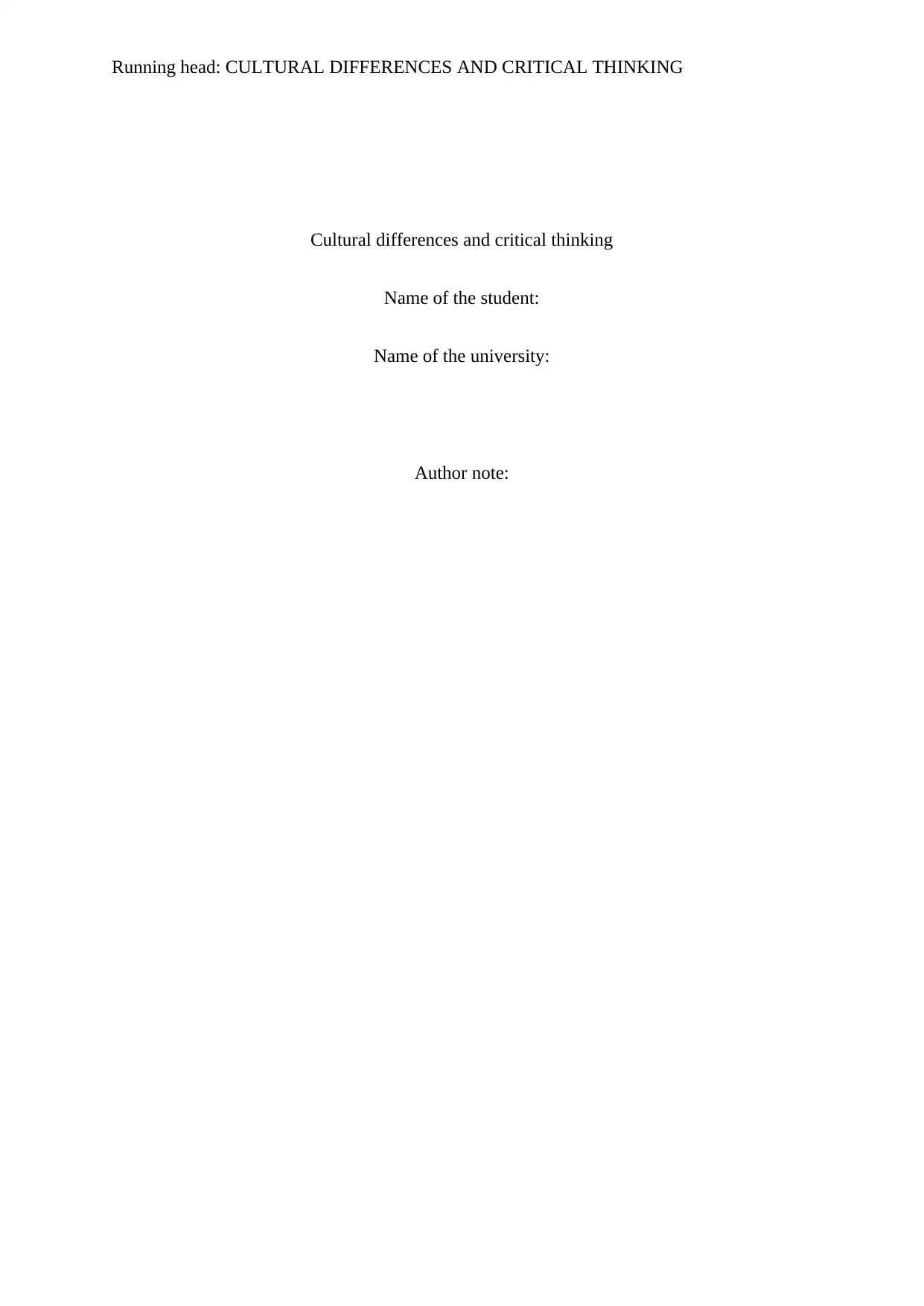
Running head: CULTURAL DIFFERENCES AND CRITICAL THINKING
Cultural differences and critical thinking
Name of the student:
Name of the university:
Author note:
Cultural differences and critical thinking
Name of the student:
Name of the university:
Author note:
Paraphrase This Document
Need a fresh take? Get an instant paraphrase of this document with our AI Paraphraser
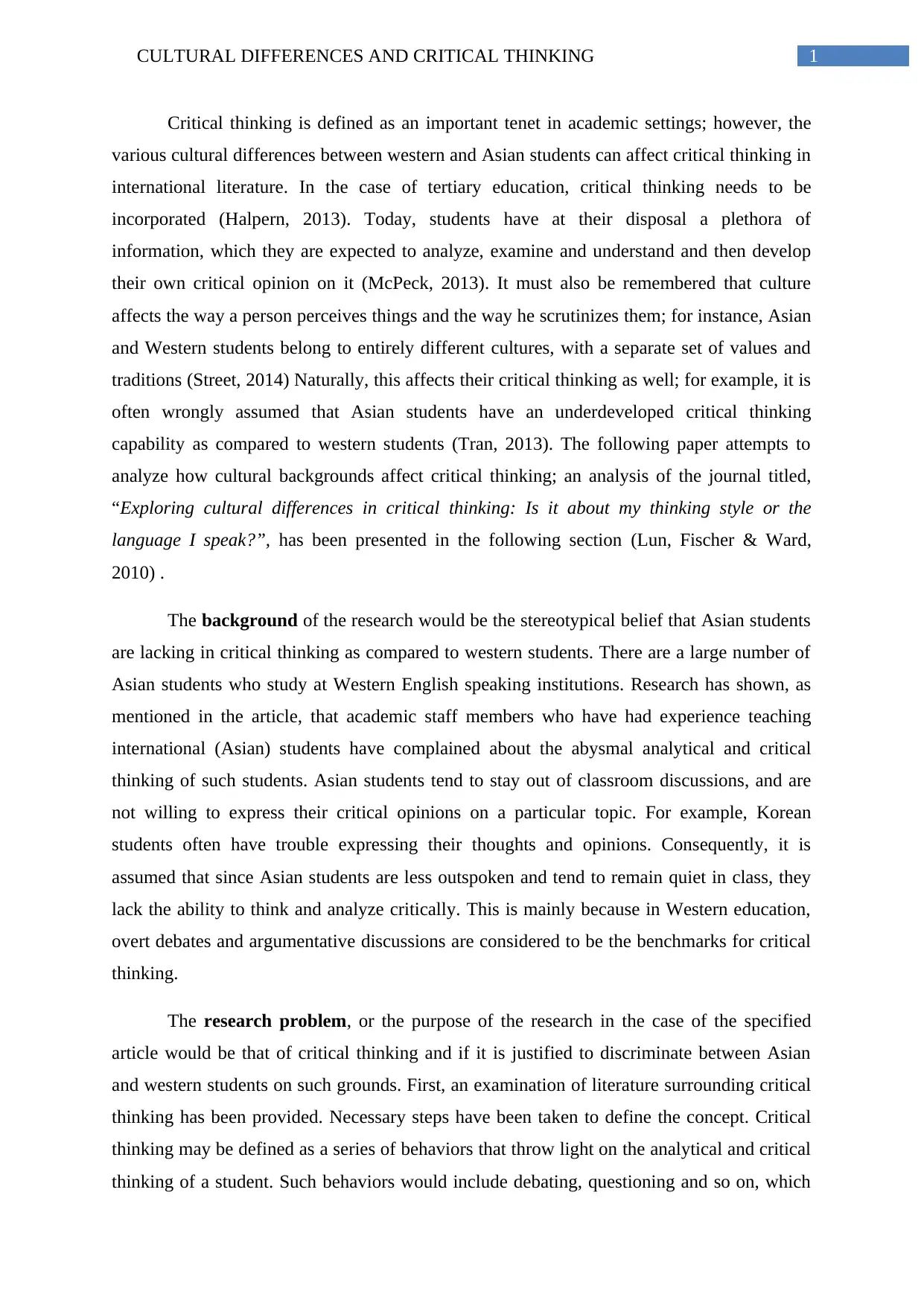
1CULTURAL DIFFERENCES AND CRITICAL THINKING
Critical thinking is defined as an important tenet in academic settings; however, the
various cultural differences between western and Asian students can affect critical thinking in
international literature. In the case of tertiary education, critical thinking needs to be
incorporated (Halpern, 2013). Today, students have at their disposal a plethora of
information, which they are expected to analyze, examine and understand and then develop
their own critical opinion on it (McPeck, 2013). It must also be remembered that culture
affects the way a person perceives things and the way he scrutinizes them; for instance, Asian
and Western students belong to entirely different cultures, with a separate set of values and
traditions (Street, 2014) Naturally, this affects their critical thinking as well; for example, it is
often wrongly assumed that Asian students have an underdeveloped critical thinking
capability as compared to western students (Tran, 2013). The following paper attempts to
analyze how cultural backgrounds affect critical thinking; an analysis of the journal titled,
“Exploring cultural differences in critical thinking: Is it about my thinking style or the
language I speak?”, has been presented in the following section (Lun, Fischer & Ward,
2010) .
The background of the research would be the stereotypical belief that Asian students
are lacking in critical thinking as compared to western students. There are a large number of
Asian students who study at Western English speaking institutions. Research has shown, as
mentioned in the article, that academic staff members who have had experience teaching
international (Asian) students have complained about the abysmal analytical and critical
thinking of such students. Asian students tend to stay out of classroom discussions, and are
not willing to express their critical opinions on a particular topic. For example, Korean
students often have trouble expressing their thoughts and opinions. Consequently, it is
assumed that since Asian students are less outspoken and tend to remain quiet in class, they
lack the ability to think and analyze critically. This is mainly because in Western education,
overt debates and argumentative discussions are considered to be the benchmarks for critical
thinking.
The research problem, or the purpose of the research in the case of the specified
article would be that of critical thinking and if it is justified to discriminate between Asian
and western students on such grounds. First, an examination of literature surrounding critical
thinking has been provided. Necessary steps have been taken to define the concept. Critical
thinking may be defined as a series of behaviors that throw light on the analytical and critical
thinking of a student. Such behaviors would include debating, questioning and so on, which
Critical thinking is defined as an important tenet in academic settings; however, the
various cultural differences between western and Asian students can affect critical thinking in
international literature. In the case of tertiary education, critical thinking needs to be
incorporated (Halpern, 2013). Today, students have at their disposal a plethora of
information, which they are expected to analyze, examine and understand and then develop
their own critical opinion on it (McPeck, 2013). It must also be remembered that culture
affects the way a person perceives things and the way he scrutinizes them; for instance, Asian
and Western students belong to entirely different cultures, with a separate set of values and
traditions (Street, 2014) Naturally, this affects their critical thinking as well; for example, it is
often wrongly assumed that Asian students have an underdeveloped critical thinking
capability as compared to western students (Tran, 2013). The following paper attempts to
analyze how cultural backgrounds affect critical thinking; an analysis of the journal titled,
“Exploring cultural differences in critical thinking: Is it about my thinking style or the
language I speak?”, has been presented in the following section (Lun, Fischer & Ward,
2010) .
The background of the research would be the stereotypical belief that Asian students
are lacking in critical thinking as compared to western students. There are a large number of
Asian students who study at Western English speaking institutions. Research has shown, as
mentioned in the article, that academic staff members who have had experience teaching
international (Asian) students have complained about the abysmal analytical and critical
thinking of such students. Asian students tend to stay out of classroom discussions, and are
not willing to express their critical opinions on a particular topic. For example, Korean
students often have trouble expressing their thoughts and opinions. Consequently, it is
assumed that since Asian students are less outspoken and tend to remain quiet in class, they
lack the ability to think and analyze critically. This is mainly because in Western education,
overt debates and argumentative discussions are considered to be the benchmarks for critical
thinking.
The research problem, or the purpose of the research in the case of the specified
article would be that of critical thinking and if it is justified to discriminate between Asian
and western students on such grounds. First, an examination of literature surrounding critical
thinking has been provided. Necessary steps have been taken to define the concept. Critical
thinking may be defined as a series of behaviors that throw light on the analytical and critical
thinking of a student. Such behaviors would include debating, questioning and so on, which
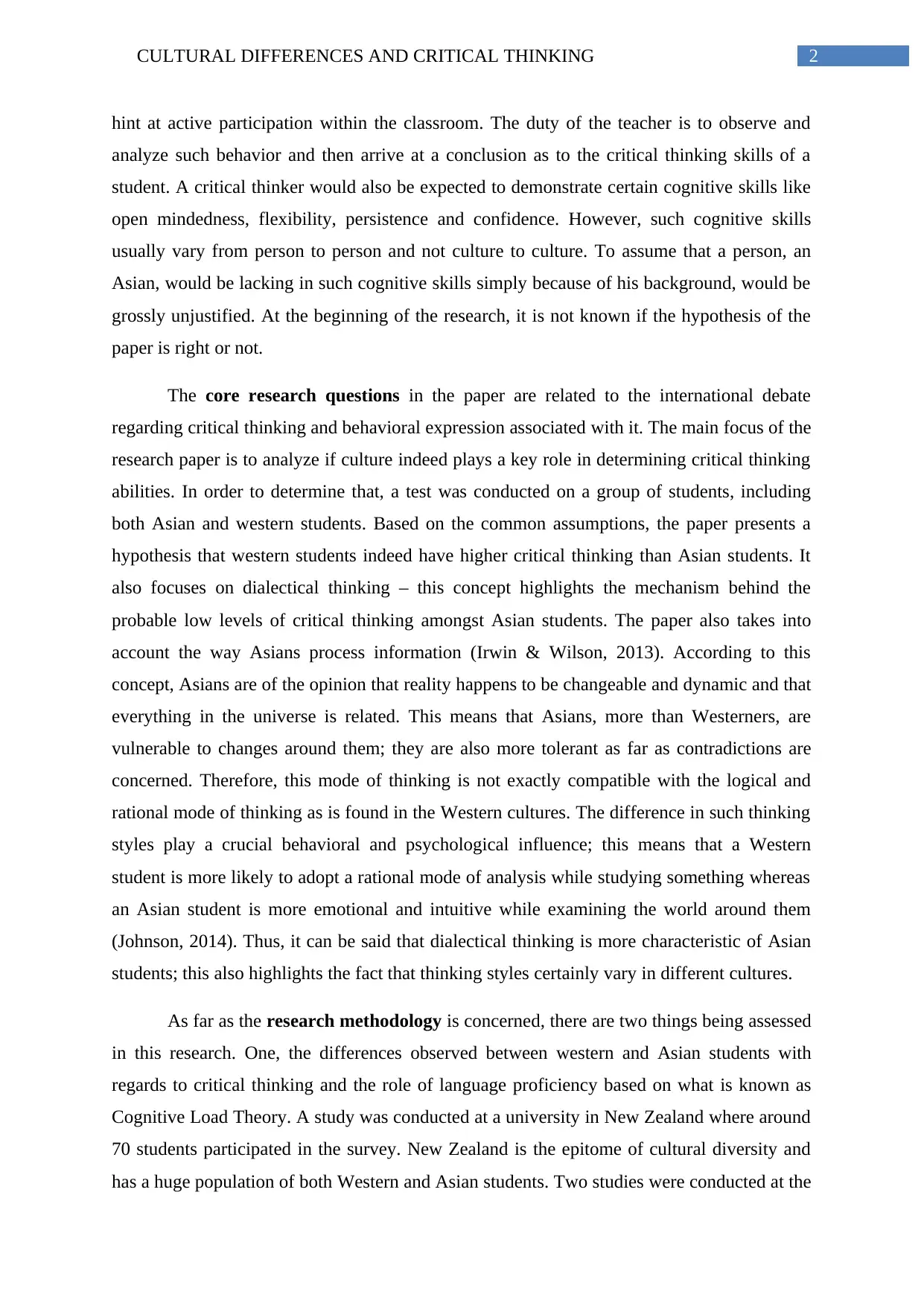
2CULTURAL DIFFERENCES AND CRITICAL THINKING
hint at active participation within the classroom. The duty of the teacher is to observe and
analyze such behavior and then arrive at a conclusion as to the critical thinking skills of a
student. A critical thinker would also be expected to demonstrate certain cognitive skills like
open mindedness, flexibility, persistence and confidence. However, such cognitive skills
usually vary from person to person and not culture to culture. To assume that a person, an
Asian, would be lacking in such cognitive skills simply because of his background, would be
grossly unjustified. At the beginning of the research, it is not known if the hypothesis of the
paper is right or not.
The core research questions in the paper are related to the international debate
regarding critical thinking and behavioral expression associated with it. The main focus of the
research paper is to analyze if culture indeed plays a key role in determining critical thinking
abilities. In order to determine that, a test was conducted on a group of students, including
both Asian and western students. Based on the common assumptions, the paper presents a
hypothesis that western students indeed have higher critical thinking than Asian students. It
also focuses on dialectical thinking – this concept highlights the mechanism behind the
probable low levels of critical thinking amongst Asian students. The paper also takes into
account the way Asians process information (Irwin & Wilson, 2013). According to this
concept, Asians are of the opinion that reality happens to be changeable and dynamic and that
everything in the universe is related. This means that Asians, more than Westerners, are
vulnerable to changes around them; they are also more tolerant as far as contradictions are
concerned. Therefore, this mode of thinking is not exactly compatible with the logical and
rational mode of thinking as is found in the Western cultures. The difference in such thinking
styles play a crucial behavioral and psychological influence; this means that a Western
student is more likely to adopt a rational mode of analysis while studying something whereas
an Asian student is more emotional and intuitive while examining the world around them
(Johnson, 2014). Thus, it can be said that dialectical thinking is more characteristic of Asian
students; this also highlights the fact that thinking styles certainly vary in different cultures.
As far as the research methodology is concerned, there are two things being assessed
in this research. One, the differences observed between western and Asian students with
regards to critical thinking and the role of language proficiency based on what is known as
Cognitive Load Theory. A study was conducted at a university in New Zealand where around
70 students participated in the survey. New Zealand is the epitome of cultural diversity and
has a huge population of both Western and Asian students. Two studies were conducted at the
hint at active participation within the classroom. The duty of the teacher is to observe and
analyze such behavior and then arrive at a conclusion as to the critical thinking skills of a
student. A critical thinker would also be expected to demonstrate certain cognitive skills like
open mindedness, flexibility, persistence and confidence. However, such cognitive skills
usually vary from person to person and not culture to culture. To assume that a person, an
Asian, would be lacking in such cognitive skills simply because of his background, would be
grossly unjustified. At the beginning of the research, it is not known if the hypothesis of the
paper is right or not.
The core research questions in the paper are related to the international debate
regarding critical thinking and behavioral expression associated with it. The main focus of the
research paper is to analyze if culture indeed plays a key role in determining critical thinking
abilities. In order to determine that, a test was conducted on a group of students, including
both Asian and western students. Based on the common assumptions, the paper presents a
hypothesis that western students indeed have higher critical thinking than Asian students. It
also focuses on dialectical thinking – this concept highlights the mechanism behind the
probable low levels of critical thinking amongst Asian students. The paper also takes into
account the way Asians process information (Irwin & Wilson, 2013). According to this
concept, Asians are of the opinion that reality happens to be changeable and dynamic and that
everything in the universe is related. This means that Asians, more than Westerners, are
vulnerable to changes around them; they are also more tolerant as far as contradictions are
concerned. Therefore, this mode of thinking is not exactly compatible with the logical and
rational mode of thinking as is found in the Western cultures. The difference in such thinking
styles play a crucial behavioral and psychological influence; this means that a Western
student is more likely to adopt a rational mode of analysis while studying something whereas
an Asian student is more emotional and intuitive while examining the world around them
(Johnson, 2014). Thus, it can be said that dialectical thinking is more characteristic of Asian
students; this also highlights the fact that thinking styles certainly vary in different cultures.
As far as the research methodology is concerned, there are two things being assessed
in this research. One, the differences observed between western and Asian students with
regards to critical thinking and the role of language proficiency based on what is known as
Cognitive Load Theory. A study was conducted at a university in New Zealand where around
70 students participated in the survey. New Zealand is the epitome of cultural diversity and
has a huge population of both Western and Asian students. Two studies were conducted at the
⊘ This is a preview!⊘
Do you want full access?
Subscribe today to unlock all pages.

Trusted by 1+ million students worldwide
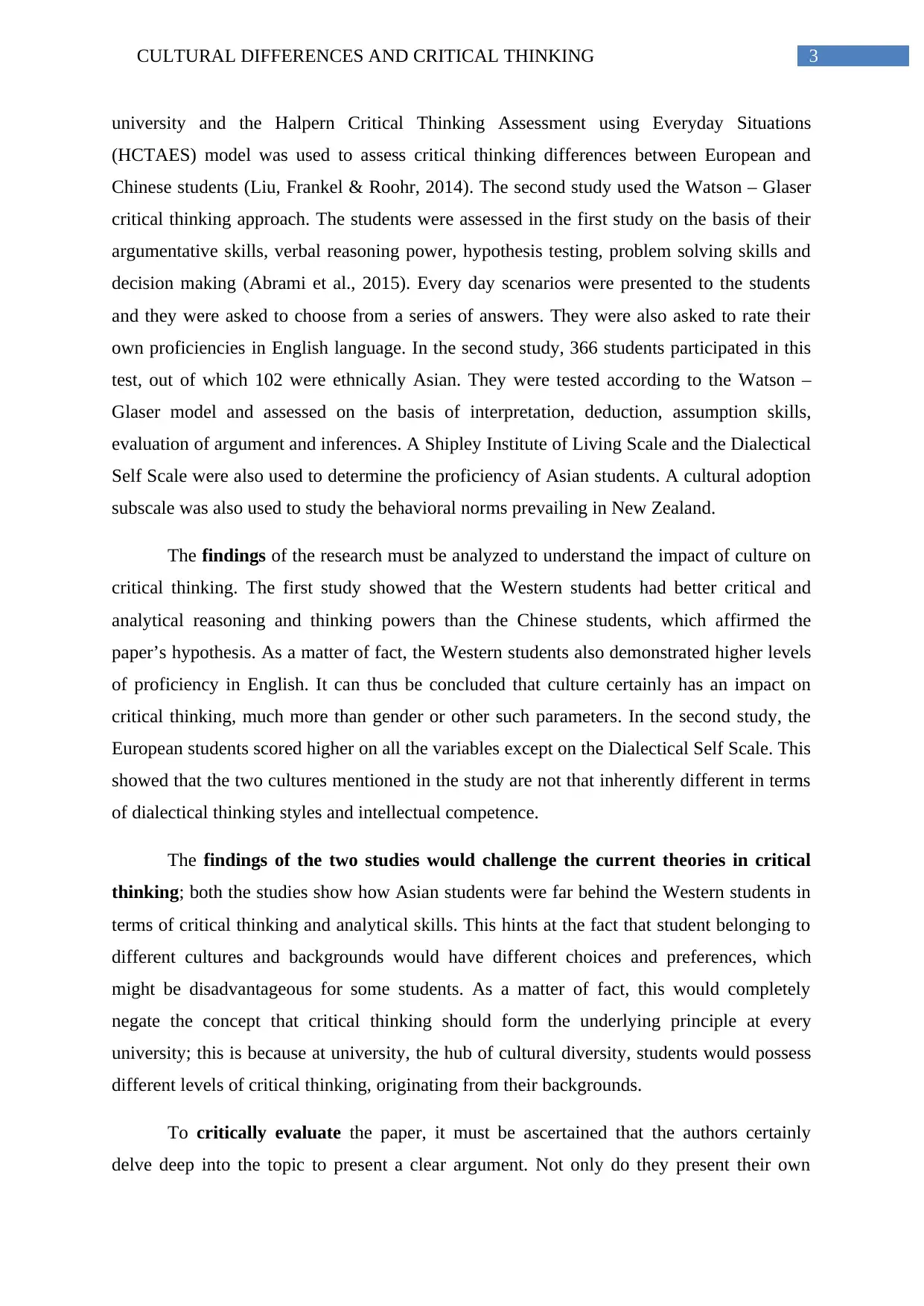
3CULTURAL DIFFERENCES AND CRITICAL THINKING
university and the Halpern Critical Thinking Assessment using Everyday Situations
(HCTAES) model was used to assess critical thinking differences between European and
Chinese students (Liu, Frankel & Roohr, 2014). The second study used the Watson – Glaser
critical thinking approach. The students were assessed in the first study on the basis of their
argumentative skills, verbal reasoning power, hypothesis testing, problem solving skills and
decision making (Abrami et al., 2015). Every day scenarios were presented to the students
and they were asked to choose from a series of answers. They were also asked to rate their
own proficiencies in English language. In the second study, 366 students participated in this
test, out of which 102 were ethnically Asian. They were tested according to the Watson –
Glaser model and assessed on the basis of interpretation, deduction, assumption skills,
evaluation of argument and inferences. A Shipley Institute of Living Scale and the Dialectical
Self Scale were also used to determine the proficiency of Asian students. A cultural adoption
subscale was also used to study the behavioral norms prevailing in New Zealand.
The findings of the research must be analyzed to understand the impact of culture on
critical thinking. The first study showed that the Western students had better critical and
analytical reasoning and thinking powers than the Chinese students, which affirmed the
paper’s hypothesis. As a matter of fact, the Western students also demonstrated higher levels
of proficiency in English. It can thus be concluded that culture certainly has an impact on
critical thinking, much more than gender or other such parameters. In the second study, the
European students scored higher on all the variables except on the Dialectical Self Scale. This
showed that the two cultures mentioned in the study are not that inherently different in terms
of dialectical thinking styles and intellectual competence.
The findings of the two studies would challenge the current theories in critical
thinking; both the studies show how Asian students were far behind the Western students in
terms of critical thinking and analytical skills. This hints at the fact that student belonging to
different cultures and backgrounds would have different choices and preferences, which
might be disadvantageous for some students. As a matter of fact, this would completely
negate the concept that critical thinking should form the underlying principle at every
university; this is because at university, the hub of cultural diversity, students would possess
different levels of critical thinking, originating from their backgrounds.
To critically evaluate the paper, it must be ascertained that the authors certainly
delve deep into the topic to present a clear argument. Not only do they present their own
university and the Halpern Critical Thinking Assessment using Everyday Situations
(HCTAES) model was used to assess critical thinking differences between European and
Chinese students (Liu, Frankel & Roohr, 2014). The second study used the Watson – Glaser
critical thinking approach. The students were assessed in the first study on the basis of their
argumentative skills, verbal reasoning power, hypothesis testing, problem solving skills and
decision making (Abrami et al., 2015). Every day scenarios were presented to the students
and they were asked to choose from a series of answers. They were also asked to rate their
own proficiencies in English language. In the second study, 366 students participated in this
test, out of which 102 were ethnically Asian. They were tested according to the Watson –
Glaser model and assessed on the basis of interpretation, deduction, assumption skills,
evaluation of argument and inferences. A Shipley Institute of Living Scale and the Dialectical
Self Scale were also used to determine the proficiency of Asian students. A cultural adoption
subscale was also used to study the behavioral norms prevailing in New Zealand.
The findings of the research must be analyzed to understand the impact of culture on
critical thinking. The first study showed that the Western students had better critical and
analytical reasoning and thinking powers than the Chinese students, which affirmed the
paper’s hypothesis. As a matter of fact, the Western students also demonstrated higher levels
of proficiency in English. It can thus be concluded that culture certainly has an impact on
critical thinking, much more than gender or other such parameters. In the second study, the
European students scored higher on all the variables except on the Dialectical Self Scale. This
showed that the two cultures mentioned in the study are not that inherently different in terms
of dialectical thinking styles and intellectual competence.
The findings of the two studies would challenge the current theories in critical
thinking; both the studies show how Asian students were far behind the Western students in
terms of critical thinking and analytical skills. This hints at the fact that student belonging to
different cultures and backgrounds would have different choices and preferences, which
might be disadvantageous for some students. As a matter of fact, this would completely
negate the concept that critical thinking should form the underlying principle at every
university; this is because at university, the hub of cultural diversity, students would possess
different levels of critical thinking, originating from their backgrounds.
To critically evaluate the paper, it must be ascertained that the authors certainly
delve deep into the topic to present a clear argument. Not only do they present their own
Paraphrase This Document
Need a fresh take? Get an instant paraphrase of this document with our AI Paraphraser
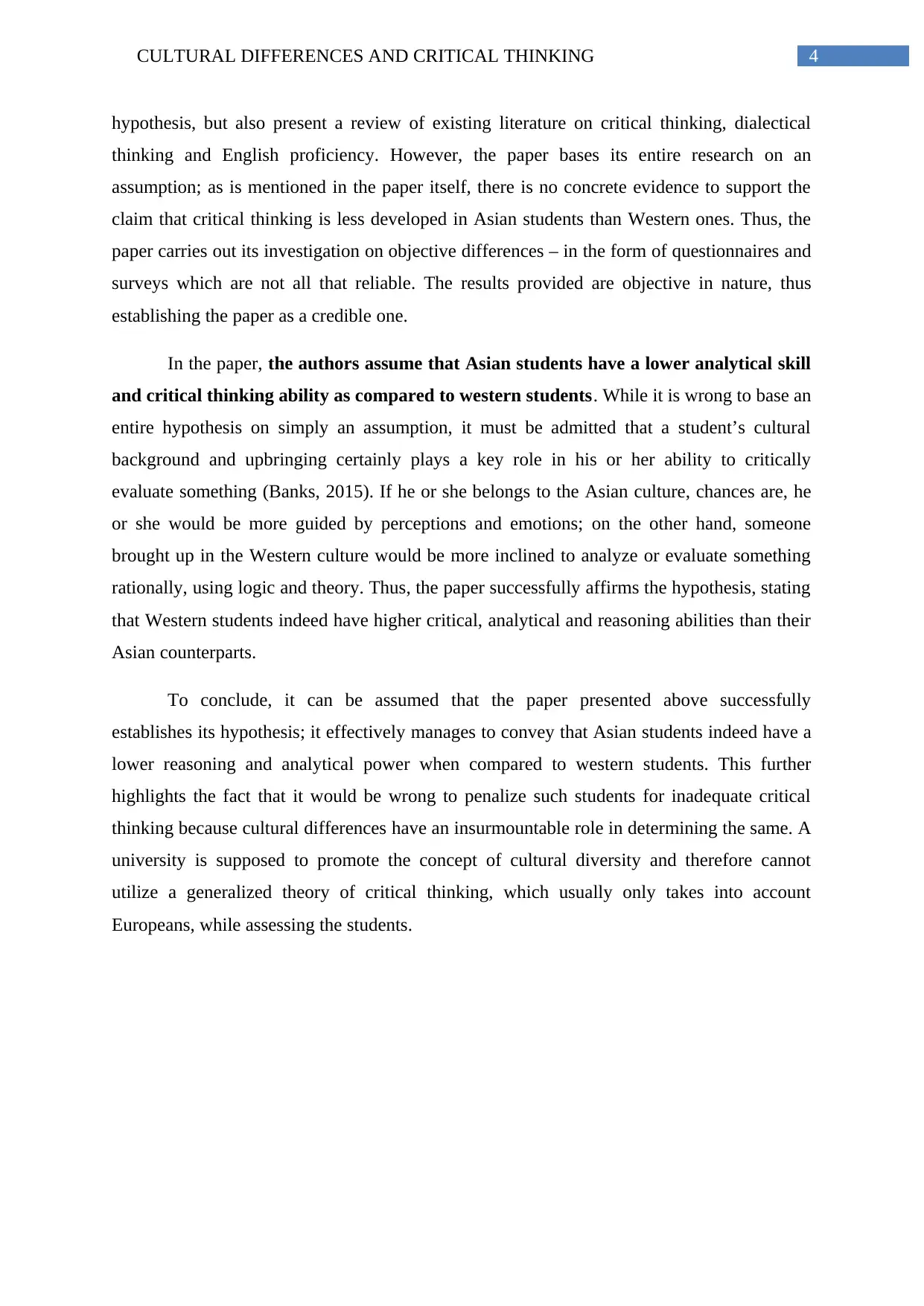
4CULTURAL DIFFERENCES AND CRITICAL THINKING
hypothesis, but also present a review of existing literature on critical thinking, dialectical
thinking and English proficiency. However, the paper bases its entire research on an
assumption; as is mentioned in the paper itself, there is no concrete evidence to support the
claim that critical thinking is less developed in Asian students than Western ones. Thus, the
paper carries out its investigation on objective differences – in the form of questionnaires and
surveys which are not all that reliable. The results provided are objective in nature, thus
establishing the paper as a credible one.
In the paper, the authors assume that Asian students have a lower analytical skill
and critical thinking ability as compared to western students. While it is wrong to base an
entire hypothesis on simply an assumption, it must be admitted that a student’s cultural
background and upbringing certainly plays a key role in his or her ability to critically
evaluate something (Banks, 2015). If he or she belongs to the Asian culture, chances are, he
or she would be more guided by perceptions and emotions; on the other hand, someone
brought up in the Western culture would be more inclined to analyze or evaluate something
rationally, using logic and theory. Thus, the paper successfully affirms the hypothesis, stating
that Western students indeed have higher critical, analytical and reasoning abilities than their
Asian counterparts.
To conclude, it can be assumed that the paper presented above successfully
establishes its hypothesis; it effectively manages to convey that Asian students indeed have a
lower reasoning and analytical power when compared to western students. This further
highlights the fact that it would be wrong to penalize such students for inadequate critical
thinking because cultural differences have an insurmountable role in determining the same. A
university is supposed to promote the concept of cultural diversity and therefore cannot
utilize a generalized theory of critical thinking, which usually only takes into account
Europeans, while assessing the students.
hypothesis, but also present a review of existing literature on critical thinking, dialectical
thinking and English proficiency. However, the paper bases its entire research on an
assumption; as is mentioned in the paper itself, there is no concrete evidence to support the
claim that critical thinking is less developed in Asian students than Western ones. Thus, the
paper carries out its investigation on objective differences – in the form of questionnaires and
surveys which are not all that reliable. The results provided are objective in nature, thus
establishing the paper as a credible one.
In the paper, the authors assume that Asian students have a lower analytical skill
and critical thinking ability as compared to western students. While it is wrong to base an
entire hypothesis on simply an assumption, it must be admitted that a student’s cultural
background and upbringing certainly plays a key role in his or her ability to critically
evaluate something (Banks, 2015). If he or she belongs to the Asian culture, chances are, he
or she would be more guided by perceptions and emotions; on the other hand, someone
brought up in the Western culture would be more inclined to analyze or evaluate something
rationally, using logic and theory. Thus, the paper successfully affirms the hypothesis, stating
that Western students indeed have higher critical, analytical and reasoning abilities than their
Asian counterparts.
To conclude, it can be assumed that the paper presented above successfully
establishes its hypothesis; it effectively manages to convey that Asian students indeed have a
lower reasoning and analytical power when compared to western students. This further
highlights the fact that it would be wrong to penalize such students for inadequate critical
thinking because cultural differences have an insurmountable role in determining the same. A
university is supposed to promote the concept of cultural diversity and therefore cannot
utilize a generalized theory of critical thinking, which usually only takes into account
Europeans, while assessing the students.
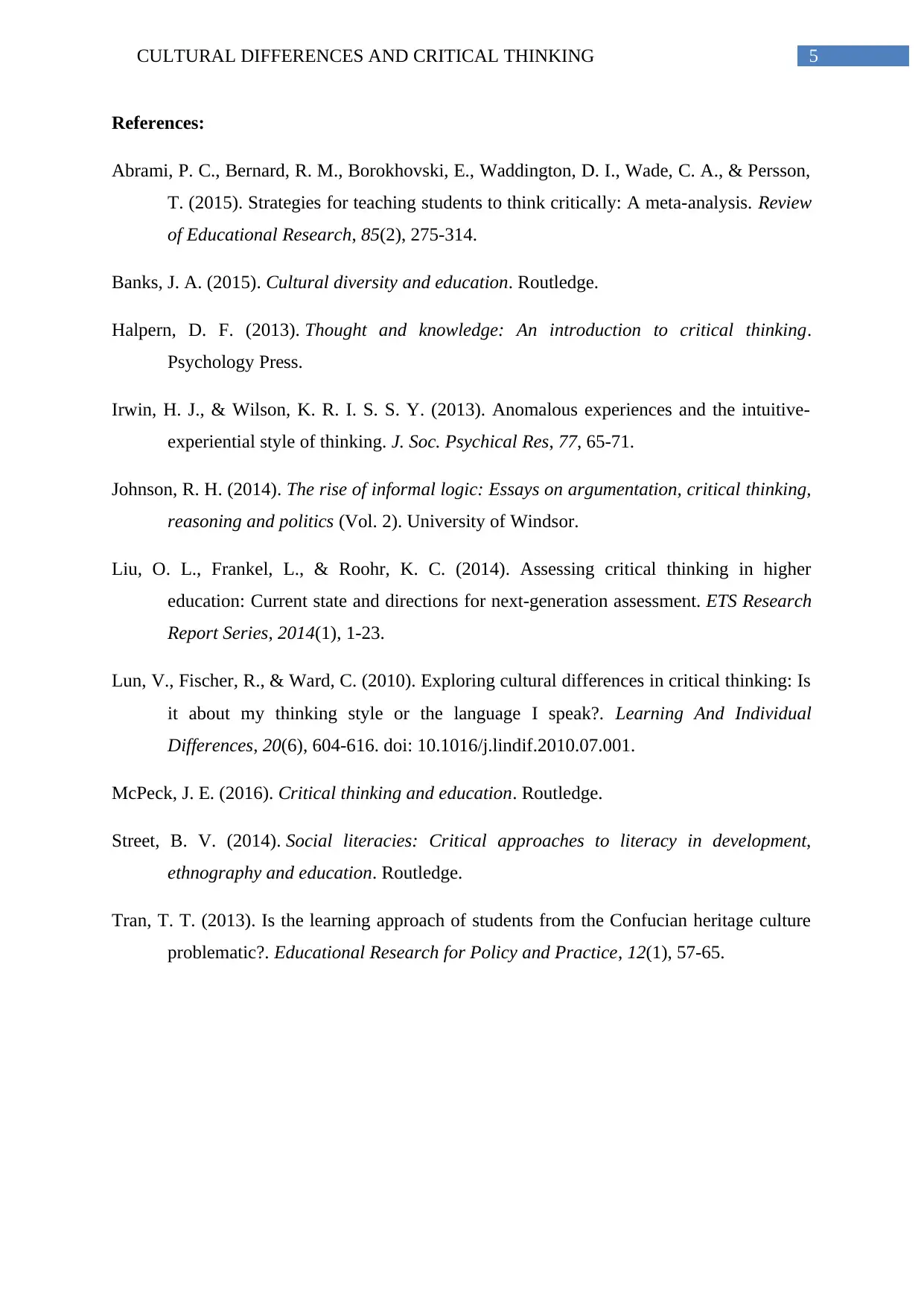
5CULTURAL DIFFERENCES AND CRITICAL THINKING
References:
Abrami, P. C., Bernard, R. M., Borokhovski, E., Waddington, D. I., Wade, C. A., & Persson,
T. (2015). Strategies for teaching students to think critically: A meta-analysis. Review
of Educational Research, 85(2), 275-314.
Banks, J. A. (2015). Cultural diversity and education. Routledge.
Halpern, D. F. (2013). Thought and knowledge: An introduction to critical thinking.
Psychology Press.
Irwin, H. J., & Wilson, K. R. I. S. S. Y. (2013). Anomalous experiences and the intuitive-
experiential style of thinking. J. Soc. Psychical Res, 77, 65-71.
Johnson, R. H. (2014). The rise of informal logic: Essays on argumentation, critical thinking,
reasoning and politics (Vol. 2). University of Windsor.
Liu, O. L., Frankel, L., & Roohr, K. C. (2014). Assessing critical thinking in higher
education: Current state and directions for next‐generation assessment. ETS Research
Report Series, 2014(1), 1-23.
Lun, V., Fischer, R., & Ward, C. (2010). Exploring cultural differences in critical thinking: Is
it about my thinking style or the language I speak?. Learning And Individual
Differences, 20(6), 604-616. doi: 10.1016/j.lindif.2010.07.001.
McPeck, J. E. (2016). Critical thinking and education. Routledge.
Street, B. V. (2014). Social literacies: Critical approaches to literacy in development,
ethnography and education. Routledge.
Tran, T. T. (2013). Is the learning approach of students from the Confucian heritage culture
problematic?. Educational Research for Policy and Practice, 12(1), 57-65.
References:
Abrami, P. C., Bernard, R. M., Borokhovski, E., Waddington, D. I., Wade, C. A., & Persson,
T. (2015). Strategies for teaching students to think critically: A meta-analysis. Review
of Educational Research, 85(2), 275-314.
Banks, J. A. (2015). Cultural diversity and education. Routledge.
Halpern, D. F. (2013). Thought and knowledge: An introduction to critical thinking.
Psychology Press.
Irwin, H. J., & Wilson, K. R. I. S. S. Y. (2013). Anomalous experiences and the intuitive-
experiential style of thinking. J. Soc. Psychical Res, 77, 65-71.
Johnson, R. H. (2014). The rise of informal logic: Essays on argumentation, critical thinking,
reasoning and politics (Vol. 2). University of Windsor.
Liu, O. L., Frankel, L., & Roohr, K. C. (2014). Assessing critical thinking in higher
education: Current state and directions for next‐generation assessment. ETS Research
Report Series, 2014(1), 1-23.
Lun, V., Fischer, R., & Ward, C. (2010). Exploring cultural differences in critical thinking: Is
it about my thinking style or the language I speak?. Learning And Individual
Differences, 20(6), 604-616. doi: 10.1016/j.lindif.2010.07.001.
McPeck, J. E. (2016). Critical thinking and education. Routledge.
Street, B. V. (2014). Social literacies: Critical approaches to literacy in development,
ethnography and education. Routledge.
Tran, T. T. (2013). Is the learning approach of students from the Confucian heritage culture
problematic?. Educational Research for Policy and Practice, 12(1), 57-65.
⊘ This is a preview!⊘
Do you want full access?
Subscribe today to unlock all pages.

Trusted by 1+ million students worldwide
1 out of 6
Related Documents
Your All-in-One AI-Powered Toolkit for Academic Success.
+13062052269
info@desklib.com
Available 24*7 on WhatsApp / Email
![[object Object]](/_next/static/media/star-bottom.7253800d.svg)
Unlock your academic potential
Copyright © 2020–2025 A2Z Services. All Rights Reserved. Developed and managed by ZUCOL.





